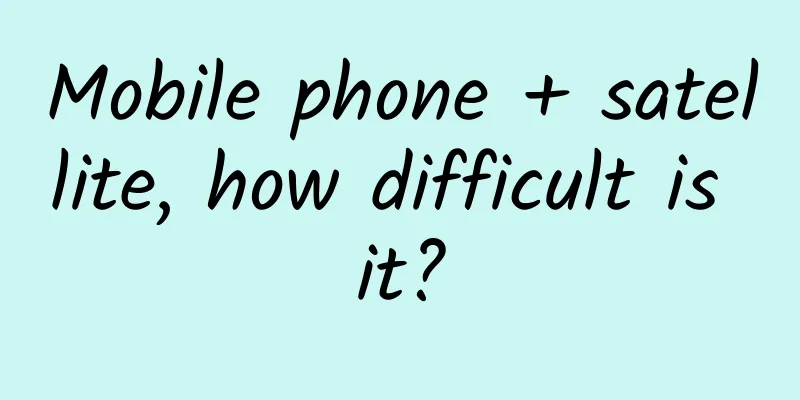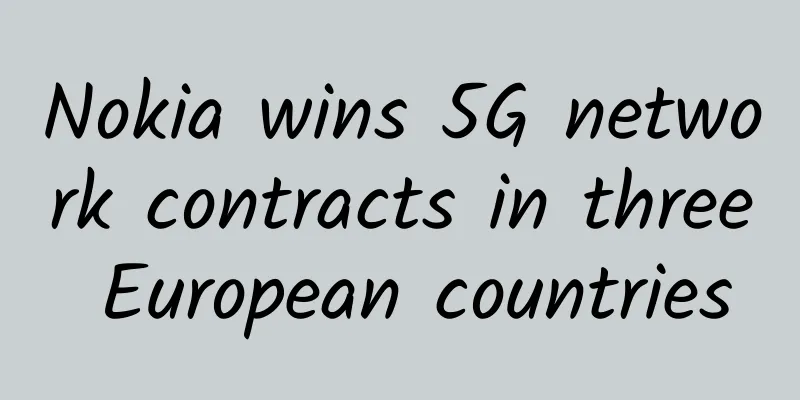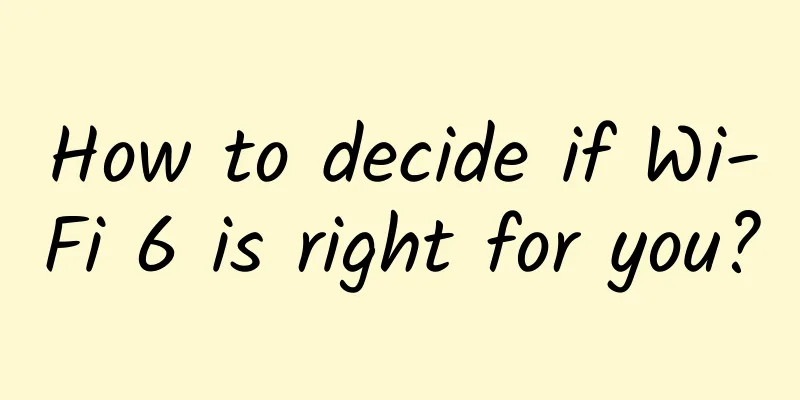Mobile phone + satellite, how difficult is it?

|
These days, news about satellite phones has become popular again. According to media reports, the Huawei Mate 50 series of mobile phones, which will be released on September 6, will have "satellite communication capabilities" and can send emergency text messages via the satellite system in places where there is no network. Coincidentally, there is another rumor claiming that Apple's iPhone 13 has hardware for connecting to satellites. However, Apple and the operators have not reached an agreement on the cooperation method, so it has not been made public. This function is likely to be realized on the future iPhone 14. The implication is that Huawei and Apple are both working hard on "satellite communications." It seems that a new "track" has appeared again. Unscrupulous traffic number, it's getting exciting again... So, is this really the case? Has the satellite era of mobile phones really begun? In this article, Xiaozaojun will give you an in-depth interpretation. Communication frequency problemIn recent years, news about satellite communications has always been a hot topic for the media and the public. Especially after Musk created Starlink, there have been news reports every few days, hyping up the threat of satellite communications to ground-based cellular mobile communications and 5G. In fact, many of these hypes lack basic communication common sense. In addition to exposing some people's eagerness for quick success and instant benefits, they are mainly for the purpose of serving traffic and capital operations. Satellite communications will never replace terrestrial mobile communications and become the main means of communication for humans, either now or in the future (at least for 50 years). Next, let me explain why - First of all, everyone should understand and remember one thing: any wireless communication system is based on radio electromagnetic waves. Radio electromagnetic waves have an important property parameter, which is frequency. Radio waves with different frequencies have different characteristics, as shown in the following figure: From a macro perspective, they are mainly divided into light waves and radio waves. We humans currently mainly use radio waves for wireless communication. Low-frequency and medium-frequency electromagnetic waves used in the early days are now gradually developing towards high frequencies and even terahertz (THz in the middle of the picture above). Some scientists are also studying visible light communication (developing towards light waves). When it comes to radio waves, it seems that there are a lot of frequency resources, but in fact, each frequency has a corresponding use specified by the relevant government departments. From the user's perspective, these frequency bands are divided into military, private network (public security, fire protection, railway, electricity, etc.), operator (public mobile communication), etc. In addition, there are ISM (Industrial, Scientific, Medical) unlicensed frequency bands, which can be used without applying for authorization, such as our Wi-Fi frequency band. No one can occupy frequencies at will. For example, if I invent a wireless communication device and then occupy the operator's 800MHz frequency band and transmit wireless signals in this frequency band, that is illegal. The first question to consider when using a mobile phone for satellite communications is: what frequency band does it use? I don’t know if you have noticed that when we buy a new mobile phone, we will see a blue label on the back: This label is the mobile phone's network access license. Before any mobile phone model is launched on the market, the manufacturer must first obtain it from the Ministry of Industry and Information Technology for network access testing. Only after the test is passed will the license be issued. This means that the country has strict requirements for every electronic product, especially electronic products with wireless signal receiving and sending functions: the radio operating frequency must comply with relevant national regulations and must comply with the legal purpose of the product. Our mobile phones are designed to work with three frequency bands: one is the operating frequency of the operator's cellular communication system (that is, the operating frequency band of the base station). If it is a common full-network mobile phone, it must support 2G/3G/4G/5G frequency bands. Each frequency band is indicated on the official website. Frequency bands supported by a certain Xiaomi model The second type is Wi-Fi and Bluetooth. This is the unlicensed spectrum I mentioned earlier, the ISM band. As long as the transmission power meets the requirements (not too high), it can be used directly. The third type is the working frequency band of the satellite positioning system. Our mobile phones now support GNSS satellite positioning and can send and receive satellite signals. There are many types of GNSS systems, including the US GPS, China's Beidou (BDS), Europe's Galileo, and so on. Numerous satellite navigation and positioning systems So, here comes the question. Many people say that mobile phones communicate via satellites every day. If they really want to communicate, what frequency band should they use? Satellite communications belong to space radio communications, which have exceeded the radio management capabilities of a sovereign state. Therefore, the use of satellite communication working frequency resources must be applied to the International Telecommunication Union (ITU-R). ITU-R has clear documents and strict requirements for application procedures and rules, which are often carried out simultaneously with the application for satellite orbit resources. Satellite communications operate in the microwave frequency band, and its frequency range is 1GHz~40GHz. According to the frequency band, it can be divided into: L, S, C, X, Ku, K, Ka. Among them, the K band is not suitable for satellite communications because it is in the frequency window with the greatest impact of atmospheric absorption loss. Therefore, the commonly used satellite communication frequency bands are: L, S, C, X, Ku, Ka: It is worth mentioning the Ka band. Since the C and Ku bands are almost saturated and cannot carry more services, the Ka band is gradually becoming popular. The Ka band is more susceptible to weather than the Ku band, but has a larger working bandwidth and higher signal strength. In any case, the satellite communication band and the operator's cellular communication band are different. Ordinary mobile phones currently sold on the market do not support the wireless working frequency of communication satellites at all, so they naturally cannot communicate with satellites. Only dedicated satellite phones provided by satellite communication service providers can establish connections with these communication satellites. The phone bills of these satellite phones must also be recharged to the corresponding satellite phone service providers. As mentioned earlier, mobile phones can communicate with GPS and Beidou, which are positioning and navigation satellites. Strictly speaking, they are not communication satellites. However, our country's Beidou is very powerful. In addition to positioning, navigation and timing services, it has one more function than GPS, which is short message communication capability. That is to say, in addition to location information, it can also communicate short messages (RDSS protocol). How short? Up to 78 hexadecimal digits/English/numbers, or 39 Chinese characters. The "satellite communication" function of Huawei MATE 50 mentioned above refers to this. With the help of the short message communication channel of the Beidou positioning satellite, in an emergency, text messages can be sent and received for emergency communication. This is just a text message. There is no data service, you can't see pictures, and you can't make calls or watch videos. This is very different from the satellite communication that everyone understands in the normal sense. The dedicated satellite phone mentioned above can make calls and use data services (surfing the Internet). Currently, the mobile phones on the market do not support the frequency band of communication satellites. So, is it possible to add it? It's not that simple. Supporting the communication frequency band of a mobile phone is not just about adding an antenna. It involves the transformation of the SoC chip, baseband, radio frequency, and software, which is a very large and complex task. It's not that it can't be done, but it's meaningless. Because in most cases, mobile phones have base station signals or Wi-Fi signals, so there is no need to increase unnecessary costs for rare situations. (It is more feasible to make an external satellite communication kit.) This is the same as the principle of amphibious vehicles. It is possible to combine the functions of a car with a ship, but the price will increase several times, and the utilization rate will be extremely low, which is not conducive to the popularization of cars. So, if the mobile phone is not modified and does not support the existing satellite communication operating frequency, is it impossible to carry out satellite communication? Not really. We can think in a different way. If the mobile phone does not support satellite communication frequencies, then why not let the satellite directly use the frequencies of ground cellular base stations? In fact, the new project of US operator T-Mobile and Musk is done in this way. They let the satellite use part of the 5G frequency band, improve the antenna, and then send wireless communication signals to the ground. This way of working has an important prerequisite, which is that low-orbit satellites must be used. In recent years, there has been a very important development trend in satellite communications, that is, the rise of low-orbit satellites. In the past, the cost of launching a satellite was very high, so people hoped that a satellite could cover a large area. If you want to cover a large area, you must put the satellite higher. As shown in the following figure: Although high-orbit satellites cover a large area, they are far away, making communication more difficult. At that time, communication technology was not very mature, so the bandwidth of the wireless channel was relatively low and the communication rate was relatively slow. This low-rate communication could only barely meet the needs of positioning and navigation. Now, with the maturity of technology and the widespread application of the technology of launching multiple satellites with one rocket, the cost of launching satellites has dropped. Private companies represented by Musk's Space-X have adopted rocket recovery technology to further reduce the cost of satellite launch, making it possible to lay a large number of low-orbit communication satellites. Trypophobia patients please beware Low-orbit satellites are closer to the ground. If weather factors are ignored, they are all within line of sight, so they can provide signal services to ground users. The orbital altitude of Starlink satellites was originally 1,110 to 1,325 kilometers, but was later lowered to 540 to 570 kilometers. Simply put, it is equivalent to hanging the base station in the sky, but the distance is a little farther. So, what is the bandwidth rate that T-Mobile's satellite communication technology can provide? 2-4 Mbps. Yes, you read it right, it is the same level as the ADSL dial-up Internet access back then. It is barely enough to make calls, send pictures and videos. Musk's traditional Starlink mainly uses satellite communication dedicated frequency bands. Based on the advantage of the existing number of satellites, it can currently reach a service rate of about 300Mbps. Attention! Starlink belongs to a conventional satellite communication system. It is not the mobile phone that reaches this rate, but the satellite communication equipment it is equipped with. This equipment has a "pot" (butterfly antenna) and a router and so on. Starlink Device Unboxing Starlink device antenna unfolded So, why can't mobile phones achieve higher satellite communication rates? This has a lot to do with the hardware of the mobile phone, especially the type of antenna, which has a great impact. Antenna type questionOur current mobile phones all have built-in antennas, and the antennas are all inside the phone. Dedicated satellite phones will have larger and more eye-catching antennas, as shown in the following figure: Satellite Phone According to antenna principles, when the length of the antenna is 1/4 of the wavelength of the radio signal, the antenna's transmission and reception conversion efficiency is higher. The satellite phone's antenna is so large, which means that the working wavelength of this communication system is longer. It also means that its working frequency is shorter (frequency = speed of light ÷ wavelength). Based on middle school physics knowledge, low-frequency (large wavelength) wireless signals have stronger diffraction ability and longer propagation distance. This matches the scenario of satellite communication. The signal receiving and sending ability of the whip antenna is relatively weak after all. A stronger one is the dish antenna, which is the common "dish". As long as the dish antenna is pointed correctly, it can achieve better communication effects. So, I want to ask, if your mobile phone is communicating with satellites, would you be willing to carry another pot on your phone? And then you should try your best to find the right direction for this pot. Even if you are willing to take the blame, you still face a problem - the problem of transmitting signals. When a satellite transmits a signal to a mobile phone, the transmission power can be increased. But when a mobile phone transmits a signal to a satellite, it is difficult. The transmission power of a handheld communication terminal is strictly limited. You don’t want to communicate with a microwave oven in your hand, do you? With the milliwatt wireless transmission power of a mobile phone, how difficult is it to get a satellite to receive such a signal? You can imagine it yourself. What’s more, thousands or even hundreds of thousands of mobile phones are sending signals to satellites in space. Do you think the satellite can capture all the signals? Musk's Starlink also has the problem of insufficient uplink speed, which is a fatal flaw. Capacity issuesOkay, let’s continue with the analysis. Next, let’s talk about capacity. Musk's Starlink is said to have 12,000 satellites to cover the world. A simple average shows that China has an area of 9.6 million square kilometers and the earth has an area of 510 million square kilometers, accounting for about 1.88%. There are only 226 satellites. So, what about the number of ground base stations? The total number of base stations in China is about 10.35 million, and China Mobile alone has about 5.5 million base stations. 226 vs 5500000, even a fool can see that there is no substitution relationship. If there were no ground cellular base stations, how many satellites would we need to allow everyone to access the Internet at high speed? Even if satellites can provide point-to-multipoint services and meet the massive demand for mobile broadband connections, what about signal backhaul (i.e., satellites sending signals to ground stations)? Data centers and cloud services are all on the ground, so backhaul is necessary. The current 5G base stations only cover an area of a few square kilometers to tens of square kilometers, with hundreds of users, and the fronthaul bandwidth must reach the 25Gbps level. Can satellite communications achieve a 25Gbps communication rate with ground stations? Previously, my country conducted a test mission on a satellite, using a high-speed, high-order coherent laser communication terminal to achieve a transmission rate of 10Gbps. It seems that it is not much different from 25Gbps, but this is wireless communication, and its stability and anti-interference are far inferior to optical fiber. Moreover, the number of satellites is far less than that of base stations. If it is to be comparable to land base stations, its number needs to be extremely large. Indoor coverage issuesIn short, if satellite communications replace ground-based cellular base station communications, what about indoor signal coverage? What about basements and tunnels? What about bad weather? ConclusionAfter all this talk, I think everyone should understand. Satellite communications are completely unable to replace ground-based cellular communications systems. If someone tells you that communications satellites will replace base stations, they are either stupid or bad. As a special communication technology, the role of satellite communication is still to supplement the terrestrial cellular communication system. There are three application areas for satellite communications: 1. Satellites can play a big role in sparsely populated areas and areas where optical fibers and base stations are not convenient to deploy. There are many such areas abroad and in the central and western parts of China. Satellite phones are very useful for some outdoor enthusiasts and people working in special fields such as mineral exploration and nature conservation. 2. Ocean and sky scenes, such as sailing ships and civil aircraft, have a strong demand for satellite communications. Especially in civil aviation, high-value groups such as business people have a great demand for air communications in recent years, and this type of application has developed rapidly. 3. Emergency rescue scenarios. When natural disasters such as earthquakes and floods occur and the ground communication system fails, satellites are needed for emergency communications. When looking at satellite communications, we must be rational and objective. Its market size is not at the same level as cellular mobile communications. However, the market segments it faces do have great room for development. In recent years, 3GPP's NTN (Non-terrestrial networks), SaT5G, and TC12 have all been researching integrated air-ground communications. I think there is market potential, but it is not as big as imagined. Especially NTN, which mainly focuses on the integration of satellite communications and 5G, is a supplement to 5G by satellite. It is not a departure from cellular communications and a new start. Everyone should have a basic understanding of this. For satellite communications, in addition to technical bottlenecks, a series of factors such as law, environment, and politics are also involved. |
<<: Discussion on interactive control technology of device platform based on gateway
Recommend
Talking about the "security gate" of Facebook and Google: the "cheese" and "traps" of SD-WAN
On September 28, hackers used Facebook's secu...
spinservers: San Jose 10Gbps bandwidth server starting at $109/month, upgradeable to 1Gbps unlimited data
spinservers is a site under Majestic Hosting Solu...
What does the TTL value returned by the Ping command mean and what does it do?
The ping command is used to test the connection t...
The user's preferred brand! Ruijie WIS leads the cloud management network market
Recently, the "2021 China IT User Satisfacti...
Talking about my cold thoughts on SD-WAN on the crater
SDWAN will be the most valuable investment outlet...
Different price 5G packages, different network speeds! It turns out that 5G also has different levels?
Using the same 5G network, some users can watch h...
Zhang Xianguo of DYXnet: Breaking through with AI-native hyper-connected architecture to safeguard the digital transformation of enterprises
In today's digital era, AI and large model ap...
The troublemakers that kept IT executives up at night in 2017
[51CTO.com Quick Translation] The new year has ar...
After reading this article on HTTPS, you will have no problem arguing with the interviewer
Let's learn about HTTPS. First, let me ask yo...
The EU will accelerate the layout of 5G big data. Industry organizations say it is urgent to narrow the gap with China, the United States and other countries
The European Commission issued an initiative on S...
Bloomberg: China is winning the multi-trillion dollar war for 5G
The coronavirus has not slowed down China’s stead...
Why is distributed networking an emerging trend?
The mass adoption of the Internet can be attribut...
Don't call Riverbed just a WAN optimization company anymore. It's become something more.
[51CTO.com original article] Recently, Riverbed l...
A large number of 5G users complained: "I changed to a 5G phone, but the network speed is slower than 4G"
As we all know, last year was the first year of 5...
Harbin Railway has installed wireless WIFI network on more than 1,000 trains
Wireless WiFi networks have been installed on 19 ...









